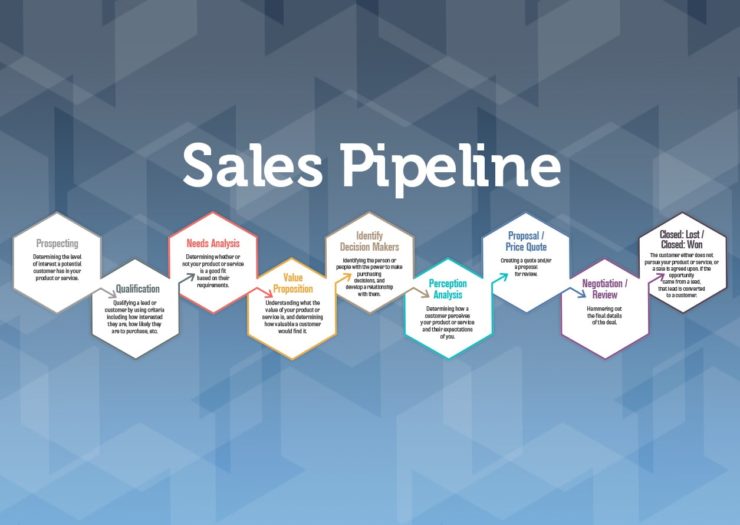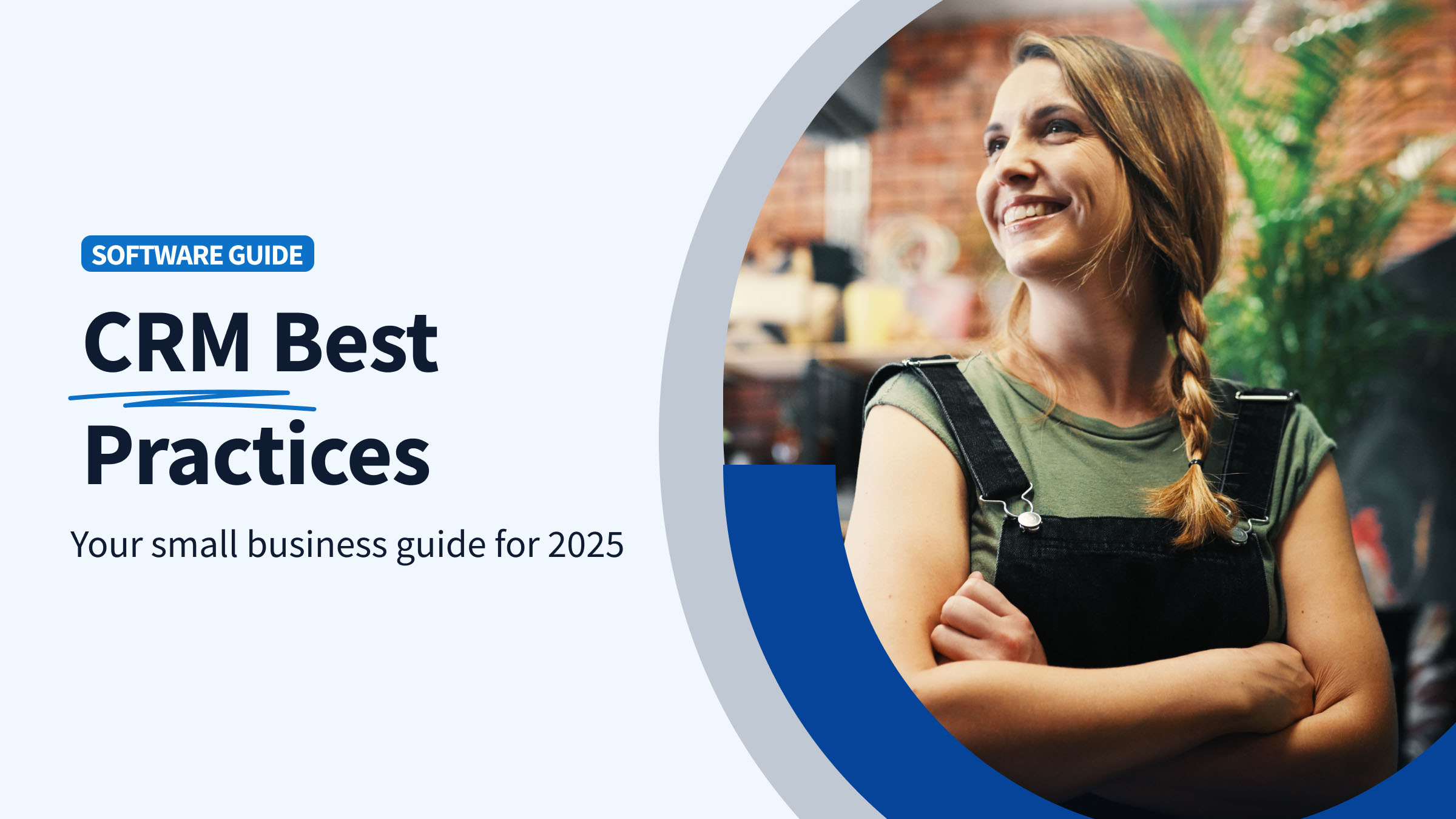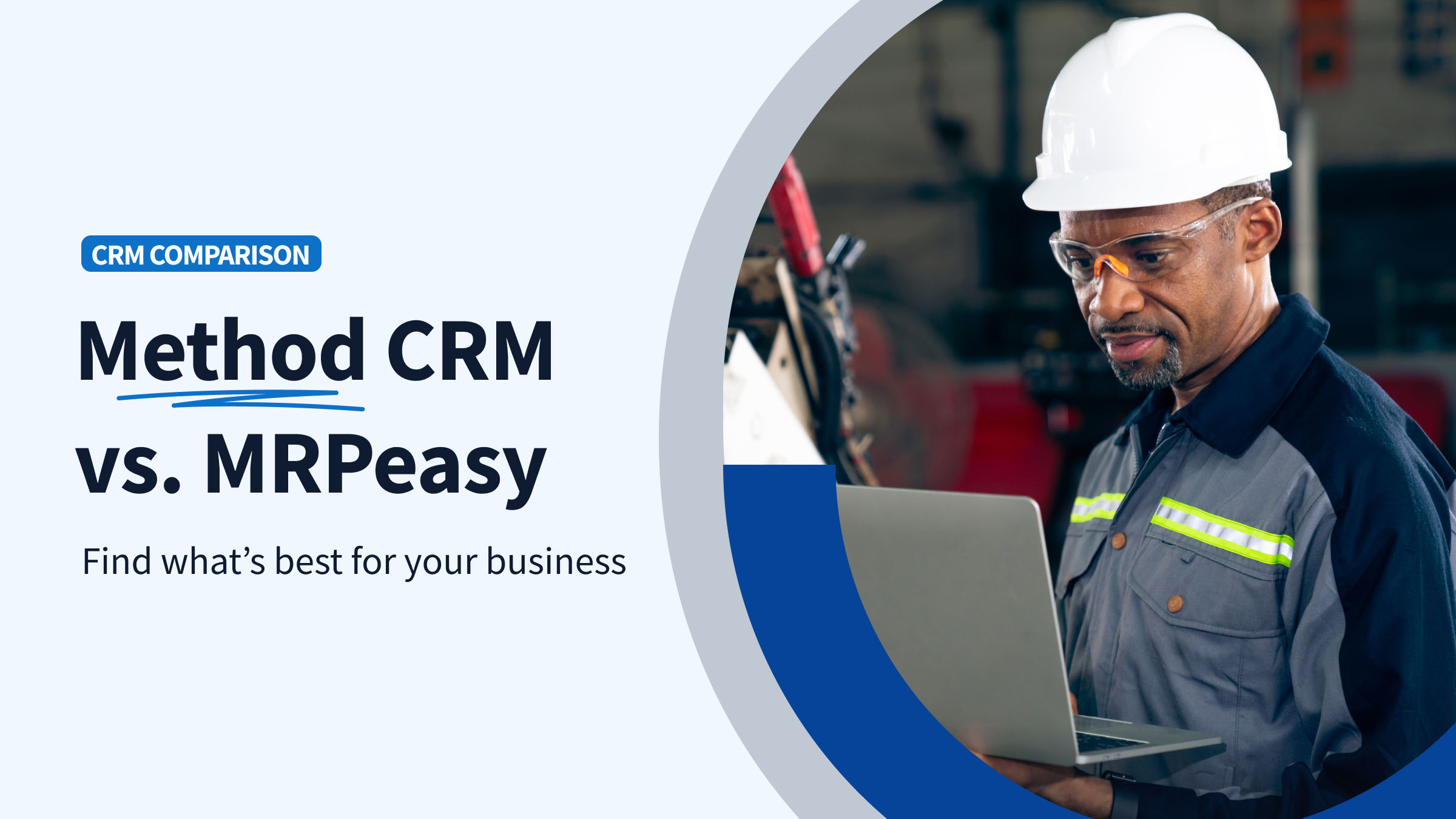In the B2B world, sales don’t appear out of thin air. Instead, most deals are closed as a result of sales reps working through sales pipeline stages that their companies have clearly defined.
These sales pipeline stages are the process by which prospective customers are moved through the buyer’s journey and converted to paying customers.
Based on our observations, the terms “sales pipeline” and “sales funnel” are often used interchangeably. But these terms actually mean very different things.
Your sales pipeline is the specific sequence of actions your team takes to convert sales leads into closed sales. This includes every tactic used from sales outreach to negotiation, and hopefully ends with a signed contract.
Let’s say your salespeople have a meeting with a prospective customer regarding pricing or the benefits of your product. That’s one of the activities comprising your sales pipeline.
Your sales funnel, on the other hand, is a visual representation of the proportion of leads that pass through each stage of the pipeline. So, your sales funnel gives you an overview of your sales process and the opportunity to gather insights from it.
This makes it one of your most valuable resources.
Together, these two concepts are used as tools by all successful sales teams to optimize their lead conversion rates. As per our expertise, a salesperson who gathers tips and generates goals around their sales process and sales funnel gives their business a leg up in its industry.
Take the guesswork out of your sales pipeline stages
Our findings show that without a clearly-defined sales pipeline, you run the risk of missing opportunities to support valuable leads and convert them into long-term, repeat customers. From lead generation to closing deals, a sales pipeline keeps your business on track at all times.
Luckily, CRM solutions like Method CRM make it simple for sales reps to track opportunities in a standardized way.
By setting up your preferred sales pipeline stages in a CRM, reps can quickly update opportunities as they progress. They can also easily identify which deals are closest to closing so they can focus their time and effort accordingly.
As leads show more interest in becoming customers in their conversations with your salespeople, you can reflect this in your sales pipeline. From there, you can adjust your approach to focus more on those hotter leads, like sending personalized emails for instance.
This makes sales pipeline management a breeze even as you achieve revenue goals and grow as a business. Drawing from our experience, it also makes life easier for your sales managers as your numbers get harder to manage.
By monitoring every sale from start to finish in a centralized system, you can measure your conversion rates at different stages and use this data as a guide to refine your sales strategy. You get total visibility of all the factors affecting your sales, all in one place.
Of course, the fact of the matter is that every company has a unique business model, so there are no “standard” sales pipeline stages that will suit every team’s needs. However, our findings show that the sales pipeline stages outlined below are a good starting point for many types of businesses.
A more in-depth comparison of sales pipeline vs sales funnel
Still confused about the difference between sales pipelines and sales funnels? Before we take you through a typical sales pipeline, let’s discuss what a sales pipeline is and isn’t.
A sales pipeline is a sequence of stages that consumers pass through to become customers. Consumers can move on to each stage after completing the one before.
Meanwhile, our research indicates that a sales funnel is more customer-focused. It shows you the steps that a consumer goes through to go from a prospect to a customer.
While a sales pipeline tells the story of how sales reps win customers over from stage to stage, a sales funnel shows the rate at which prospects are converted through each stage of the pipeline. As per our expertise, both provide valuable yet different insight into your sales activities and performance.
Our research indicates that a sales funnel typically has three major stages independent of sales cycle length:
- Top of the funnel (TOFU), which comprises the awareness and discovery phases.
- Middle of the funnel (MOFU), which includes evaluation and intent.
- Bottom of the funnel (BOFU), which is where purchases finally happen.
A sales pipeline, on the other hand, looks like this:
1. Prospecting: Identify the interest level for your product or service
Your sales pipeline should always start with prospecting or identifying your lead’s level of interest in your products or services.
Chances are, you’ll observe the highest amount of interest and activity among prospective customers who fit your marketing personas.
These personas act as representations of your target buyers and are based on the demographics and behavior of your existing customers and stakeholders.
This type of person will presumably have more of an interest in what you sell and a higher conversion rate when nurtured across every sales pipeline stage.
2. Qualification: Qualify your leads to determine value
Qualification of your sales leads is the next stage of the pipeline management process.
You will need to use certain criteria to identify which prospects are most likely to make a purchase and therefore should be pursued further. The lead’s interest level and marketing persona alignment (as determined in the previous sales pipeline stage) are important criteria. Other key items to look at include budget, need, and timeline for purchasing.
You can automate this qualification process with your CRM software or complete it by hand using a lead qualification template.
3. Needs analysis: Determine if your product or service solves pain points
At the needs analysis stage, sales reps need to take a step back and look at their products and services from the customer’s perspective. Through our practical knowledge, at this point, you should ask yourself: Where is the customer coming from and what problems are they trying to solve?
The goal here is to assess exactly how your company’s offerings can resolve certain pain points. And if the answer is that they can’t, that’s okay too. It’s better to realize this early on than to try to force a sale that won’t benefit the buyer.
4. Value proposition: Assess the value of your product or service
The fourth sales pipeline stage relates to your value proposition. This stage gives sales reps a chance to assess the value of their offerings in the scenario at hand.
Using the information gathered in your needs analysis, you must determine how valuable a customer would find your products or services, based on their pain points. Our findings show that this will improve your ability to promote your products or services in a way that speaks directly to the buyer, rather than simply stating the specs.
5. Identify decision-makers: Cultivate relationships with key contacts
In a lot of B2B sales scenarios, the individual you sell to isn’t the person who ultimately has the power to pay you. Based on our firsthand experience, at this sales pipeline stage, you need to identify and engage with key decision-makers.
Ask your current contact or do your research to find the person who makes the purchasing decisions at the company or organization in question. You must then reach out and cultivate a relationship with this individual in order to get closer to closing the sale.
6. Perception analysis: Weigh client perceptions against reality
Our research indicates that in the sixth sales pipeline stage, you have to consider that the actual value of your products or services does not always match their perceived value.
The buyer’s impressions of your offerings and your company play a big role in your team’s ability to close the sale. Not surprisingly, our findings show that leads who already hold positive or neutral perceptions at this stage offer the best outcomes for you.
However, drawing from our experience, you should also strive to develop strong sales practices that can overcome negative perceptions. Take the time to learn about your lead’s concerns and offer solutions to address them.
Also, having resources like blog posts available is a great way to help shape prospects’ perceptions of your products or services.
7. Proposal / price quote: Create a quote for review
If you reach this sales pipeline stage, things are going well as it’s now time to create an estimate or proposal for your prospective customer.
Based on our observations, while it’s good to use standardized templates for all of your company’s quotes, each one should be personalized to match the customer’s specific needs. Make sure all pain points are addressed and all relevant terms and conditions are included.
To streamline this process, look for a CRM like Method that offers quoting functionality alongside lead management.
8. Negotiation / review: Finalize the details
At this sales pipeline stage, you should review the proposal with your customer and finalize the details. This is the time to make sure they understand the terms and conditions and answer any last-minute questions they may have.
You will need to keep a close eye on things at this stage, as letting something slip through the cracks could be a dealbreaker. Our research indicates that you should use every tool at your disposal to close the sale as seamlessly as possible. Sales reps will also need to know their limitations when negotiating on behalf of their company to effectively close the sale.
When negotiating a deal, keep in mind the following stages:
Preparation
Review your customer’s needs, values, and preferences. All of this should help you anticipate any potential objections they may have about pushing through with the deal. In doing so, you can come up with a more convincing argument in defense of your product or service.
Engagement
Drawing from our experience, this is where active listening skills come in. Active listening is a sales technique that helps reps build rapport with prospects and help them truly feel understood.
Simply paying attention to a prospect’s hopes and expectations is a huge aspect of customer service that often goes overlooked. In this stage, a rep should refrain from pushing a hard sell and instead collect evidence to build a case that’s tailor-made for each prospect.
Bargaining
Now that you know your customer’s wants and needs, you can facilitate the negotiations. The point of this stage is to find a middle ground that works for all parties involved.
Becoming a customer may feel like a big commitment to your lead. So it’s important to identify any source of hesitation for your lead and reemphasize the positive impact your product or service will have on their business. This might include offering them additional bonuses such as a trial period.
9. Closed: Win or lose, close the sale
The last of the sales pipeline stages is all about closing the deal. Through our practical knowledge, whether you win or lose the sale, it’s important to see it through to the end and get a final answer from the customer.
Upon determining the results of your sales efforts, document the details in your CRM to allow for ongoing data analysis of your sales targets. Over time, we found that information on won and lost sales opportunities can help you refine your sales pipeline stages and improve your sales process.
This means that, win or lose, your sales forecasts will naturally become more ambitious each time you navigate through these sales stages.
The importance of sales pipeline analysis
Our findings show that sales pipeline analysis helps you determine what influences successes and failures and helps you pinpoint areas in the pipeline that can be improved upon to drive sales up. By fine-tuning every little detail of your pipeline, you can improve the speed at which you acquire new customers and eventually reduce the costs involved in customer acquisition.
Our research indicates that some of the top metrics to track include:
- Average deal size: This is the average amount of money that a client spends on a product or service. It is computed by adding the total revenue from a set period and dividing it by the number of closed-won opportunities within the timeframe.
- Win rate: This represents the ratio of deals won to the total closed opportunities.
- Average length of sales cycle: This is the average time spent from the first contact with a prospect to closing.
- Sales velocity: This measures the speed at which sales move through your pipeline to generate revenue.
- Lead response time: This is the average time it takes for a sales rep or a business to follow up with a lead.
- Sales pipeline value: This is the value of all qualified opportunities that entered your pipeline.
- Probability to close: This is the likelihood that deals close in a stage of the sales cycle, measured in percentages.
Make the most of your sales pipeline stages
As per our expertise, to get the most out of the sales opportunities that come your way, you must have clearly defined sales pipeline stages. Planning out sales stages is one of the most important tactics in the sales playbook.
Based on our observations, the significance of monitoring each of your sales pipeline’s stages becomes clear when you consider things through a more macro lens.
The data you pull from your pipe line and sales conversion funnel serves as one of your most useful tools when setting sales objectives.
It allows you to learn, adapt, and develop new strategies through accurate sales forecasting. So you can make clear financial goals around things like budgeting or the revenue numbers you’re reporting.
Use the examples described above as a starting point, but don’t be afraid to evaluate and refine them over time to develop the perfect sales process for your business. And keeping track of these changes makes training new employees easy for you down the road.
Ultimately, this pipeline will give your sales force the structure it needs to convert leads to lifelong customers.
Importance of sales pipeline stages FAQs
What are sales pipeline stages?
Sales pipeline stages are the steps that comprise your overall sales process. Of course, there’s more to a sale than a monetary transaction. Companies develop a relationship with prospective clients that needs to be attended to throughout the entire sales process.
For example, newer companies with less experience in their industries have little to no brand awareness. Based on our observations, while social media content falls more under general marketing tools, individualized strategies like personal emails are a key stage in the sales pipeline.
If you’re discussing the benefits of your product or service with people and how it will help their goals, that’s a key stage in the pipeline as well.
How do sales pipeline stages help salespeople prioritize their time?
Sales pipeline stages help salespeople prioritize their time by segmenting the sales process into digestible parts. This way, it’s easier to improve your sales results in the future, as you can pinpoint exactly where your sales process needs work.
Also, using sales technology or software to track your sales pipeline eliminates confusion across your company, allowing you to close sales more efficiently.
Who should be involved in the sales pipeline?
Anyone involved in your sales process in any capacity should also be involved in the sales pipeline. This includes sales managers and sales reps, as well as anyone else at your company who engages with your customers.
See how Method CRM can help you convert more of your sales pipeline.






